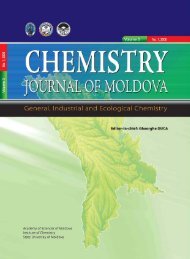2011, nr. 3 - Academia de ÅtiinÅ£e a Moldovei
2011, nr. 3 - Academia de ÅtiinÅ£e a Moldovei
2011, nr. 3 - Academia de ÅtiinÅ£e a Moldovei
Create successful ePaper yourself
Turn your PDF publications into a flip-book with our unique Google optimized e-Paper software.
110causes of the end stage renal disease, but their prevalencehas <strong>de</strong>creased from 90% till 75% during the last <strong>de</strong>ca<strong>de</strong>.Dialysis and Kidney Transplantation Center activities haveshown the continuous increase of the number of patientson chronic dialysis as well as of the number of yearlyperformed dialysis sessions with simultaneous patients’mortality reduction and increased patients survival.РезюмеХронический гломерулонефрит, тубулоинтерстициальныенефропатии и наследственные патологииостаются основной причиной терминальной стадиипочечной болезни, но их распространенность снизиласьс 90% до 75% в течение последнего десятилетия.Деятельность Центра Диализа и ТрансплантацииПочки показало непрерывное увеличение количествабольных на хроническом диализе, ежегодных сессийдиализа, с одновременным снижением смертности пациентови увеличением выживаемости пациентов.THE EFFECT OF Α-ERHYTHROPOIETINADMINISTRATIONIN DIALYSED PATIENTS_______________________________________Adrian Tănase 1,2 , universitary professor, M.D.,PhD., Head of the Urology and OperativeNephrology Department, Head of the DialysisCenter, Head Specialist in Dialysis of theMinistry of Health, Petru Cepoida 1 , M.D.,Ph.D., nephrologist1 – Public Medical-Sanitary Institution ClinicalRepublican Hospital;2. The State University of Medicine andPharmacy „Nicolae Testemiţanu”IntroductionRegular erythropoietin administration is animportant measure in the amelioration of the dialyzedpatients’ quality of life [1]. Several meta-analyses<strong>de</strong>monstrated the positive effect of erythropoietinstimulatingagents on the longevity of dialyzedpopulation [2]. Consi<strong>de</strong>ring the relatively high costof such treatment it is important to <strong>de</strong>termine thegroup of patients, who can benefit the most fromsuch treatment, providing the highest clinical effect/expenditures ratio [3]. There is a number of differentcauses of the dialyzed patients’ hyporesponsivenessto erythropoietin administration [4], although,„malnutrition-inflammation complex” is consi<strong>de</strong>redamong the most important ones [5]. There wereproposed a lot of markers, that correlate with thisBuletinul AŞMsyndrome’s severity, usually relatively costly, anare not routinely used in clinical practice. Frompractical and economical point of view it is muchmore appropriate to use well known, cheaper androutinely carried out in clinical practice markers ofinflammation such as erythrocyte sedimentation rate.Objective of the study is the evaluation of clinicaland economical efficacy of erythropoietin and bloodtransfusions in dialyzed population.Material and methodsWe have performed a evaluation of one monthα-erythropoietin (Repretine®) administration inpatients on chronic dialysis. There were studied theeffects of its administration in 52 patients versus 57patients without administration of erythropoietin.These 109 patients were selected out of 139 patientson chronic dialysis treated in the Dialysis andTransplantation Center from the Clinical RepublicanHospital at the beginning of 06.<strong>2011</strong> applying thefollowing exclusion criteria: patient’s <strong>de</strong>ath during thestudy period (1 patient), administration of both bloodtransfusions and erythropoietin (2 patients), absenceof anemia (17 patients) and lack of correspondinganalysis or clear hemorrhagic events, that nee<strong>de</strong>d bloodtransfusion (10 patients). Studied group inclu<strong>de</strong>d 66(60,6%) male and 43 (39,4%) female patients withmean age 45,89±1,24 years old and mean dialysisduration 4,73±0,43 years. Only 51 out of 109 patients(46,79%) have no hemotransfusions in the previous5 months. At the beginning of treatment 48 (44,04%)patients suffered from the 1st gra<strong>de</strong> anemia, 49(44,95%) patients suffered from the 2nd gra<strong>de</strong> anemiaand 12 (11,01%) suffered from the 3rd gra<strong>de</strong> anemia.From etiological point of view among un<strong>de</strong>rlyingpathologies predominated chronic glomerulonephritis– 48 (44,04%) patients, chronic pyelonephritis – 26(23,85%) and hereditary pathologies – 19 (17,43%).Chronic viral hepatiti<strong>de</strong>s were present in 51 patients.All studied patients were classified in 5 groups:1st group inclu<strong>de</strong>d the patients on α-erythropoietin(Repretine®) treatment and with ESR ≤ 30 mm/hour –26 (23,85%) cases; 2nd group comprised the patientson α-erythropoietin (Repretine®) treatment and withESR > 30 mm/hour – 26 (23,85%) cases, 3rd groupinclu<strong>de</strong>d the patients without erythropoietin treatmentand ESR ≤ 30 mm/hour – 17 (15,6%) cases, 4th groupinclu<strong>de</strong>d 28 (25,69%) patients without erythropoietintreatment and ESR > 30 mm/hour. The 5th group wascomprised from 12 (11,01%) patients that nee<strong>de</strong>dblood transfusions during the studied period andtook no erythropoietin treatment. All the groupshad similar <strong>de</strong>mography, un<strong>de</strong>rlining pathology anddialysis characteristics. ESR = 30 mm/hour (by theend of α-erythropoietin treatment period) was selected
















